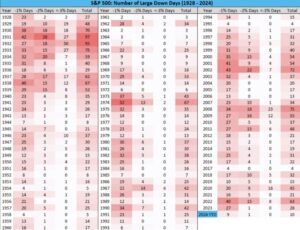The Election Is Getting Close: My Fourth-Quarter Advice to Kamala and The Donald
After my May 17 essay on the coming election, I received a few complaints from Trump supporters saying that it was nothing short of a battle plan for how the Dems could win. So this time, I’m going to even things out by giving advice to the Trump campaign as well.
Where We’re at Right Now
The Dems are feeling optimistic about November since they took Joe Biden off the ballot and his replacement, Kamala Harris, jumped ahead of Trump in the polls.
As I’ll explain in a moment, I don’t think the folks orchestrating the Democratic agenda had Kamala in mind. In fact, I believe she was never even a consideration. Her poll numbers were always low, and by mid 2023 they were even lower than Biden’s. But here she was, Biden’s unelected replacement, and the public response was very positive. Much better than they could have imagined.
More than a year ago – in January 2023 – I predicted that Biden would not be the Democratic candidate for president come November 2024. I made that prediction for several reasons, but especially because it was becoming increasingly evident to me and anyone else who was paying attention to the visible signs of his physical and cognitive decline that he could not beat Trump.
Though Biden’s many embarrassing lapses, pratfalls, and bizarre behaviors were downplayed by the mainstream media, his rapidly evolving dementia was certainly obvious to those close to him, including those few that had been running the Democrat agenda and planning his reelection. I can’t say I knew exactly who “they” were, but, mostly because I liked using the COPs acronym, I chose to focus on the influence of Clinton, Obama, and Pelosi.
Biden’s replacement had to be someone strong and skillful and likeable. I thought their obvious choice would be Gavin Newsom, who has the charisma, political intelligence, and rhetorical skills to stand up against and even defeat Trump in an extended campaign. And I wrote that if Barack could convince Michelle to be Newsom’s running mate, victory would be all but guaranteed.
I was right about Biden being ousted, but I was wrong about his replacement.
Sleepy Joe surprised the COPs and suddenly stopped taking orders. He resisted when they told him he had to step down and kept resisting. If they did nothing, it was going to be another Biden/Harris ticket with the genuine possibility of an Orange Menace Redux.
They had to act fast, so they pulled out Plan B. They called for an early debate with Trump, the earliest such “presidential debate” ever held. And I believe they knew what was going to happen. When it did, Biden knew he had to go. They had exposed what they and the establishment press had been hiding for more than a year: Biden was not capable of running for president, let alone being president.
So, Biden was gone. But did they have enough time to bring in Newsom? And would Newsom even agree to do it, since he is smart enough to know that there might not have been enough time to build the campaign he needed to win?
Someone decided: We must go with Kamala. Even if only as a temporary measure.
When the announcement was made, her likeability scores shot up. And now, the positive energy is so strong it’s palpable. Despite my best efforts, I’ve found myself irrationally swept up in it. At least she’s attractive to look at, some primitive part of my brain whispers. And she has a pulse, which is a big improvement over her boss.
Or is it? What if she wins and she and her VP begin knocking out executive orders based on their historical preferences? What if they are truly committed to doing to the nation what they did to California and Minnesota?
Don’t worry, my liberal and left-leaning readers, I won’t paint a picture of what I think will happen to America if Kamala wins. Because, despite the current frenzy of giddiness about her, there is still a possibility that the COPs have a switcheroo planned.
But if they don’t, they have a challenging job on their hands.
The Challenge Facing the Dems
Even if she is locked in a basement for much of the time between now and November, Kamala will be forced to face the public and answer questions that Trump and his team are eager to ask her.
She will be indicted for every failure and damaging decision made by the Biden administration in the last three years. Some of the charges will sting. She needs to have answers for them.
At the top of my list is what is politely referred to as their “Southern Border Policy” – the deliberate (and ruthlessly brilliant) idea of opening the Mexican border to 18 million (or was it 12 million?) illegal immigrants who would be reliant on government handouts to survive in the States, and then flying and/or busing them to various cities and suburbs across the nation.
That was step one. And it was successful beyond any reasonable expectation.
Step two was to give the immigrants driver’s licenses to make them “sort of legal” (currently allowed in 19 states and the District of Columbia). And step three will be to give them the right to vote. This would ensure Democrat dominance in the Oval Office and both houses of Congress for decades to come, and may well be Kamala’s first executive order if she is elected.
When I made my prediction about Biden’s exit, I would have said that the border issue would be lethal for Kamala. After all, she has been, in theory, the border tsar since 2020. (Amazingly, despite the mainstream press exalting her as “border tsar” ad nauseam in 2021 and 2022, they are now claiming – and she will be too – that she never had such a job. Her job was to research the “root causes” of immigration. As if that was a genuine question. Gee, why would someone who lives in, say, Nicaragua, which is safer than the US, want to emigrate to the States. Could it be that the average landscaper in Nicaragua makes less than $2,000 a year?
But once again, the COPs have done something clever. You may not have noticed, but the Dems have completely abandoned the Biden policies that let in all those millions and reinstalled Trump’s strict border policies. So now, when confronted, Kamala can say, “Joe and I solved that problem.” And the establishment press will agree.
That will help. But the election will be decided by the undecided voters, and I don’t know if they will buy the claim that the problem was solved.
The effect of an influx of millions of largely unskilled and uneducated immigrants continues to be felt across the US, including Democrat-run cities faced with the costs of giving them the “sanctuary” they had been guaranteed by the Biden administration.
Kamala also has some personal “issues” to deal with. She is not good at public speaking. And she is not particularly likeable. Even the people that work for her don’t seem to like her. But let’s put that aside.
My Latest Advice for Kamala and the Dems
The Abortion Issue
For obvious reasons, Kamala is going to be urged to spend a good part of her time and the best of her speechwriters’ rhetoric on the Supreme Court’s 2022 decision to “overturn” Roe vs. Wade by relegating abortion rights to the States.
After all, according to the latest Pew Research poll I saw, a majority, 62%, of Americans disagree with that decision. Perhaps more importantly, 43% strongly disagree.
But I think it would be a mistake for Kamala to make this a key part of her election strategy.
Here’s why.
First, a sizeable portion of Americans, 41%, believe the court’s decision was a good one, and 25% strongly agree with it. Those are minority percentages, but not overwhelmingly small. Furthermore, according to the Pew survey, adults living in the states where abortion is newly largely prohibited (or where prohibitions are set to take effect soon) are much more evenly divided: 46% approve of the court’s decision, while slightly more, 52%, disapprove.
This means to me that in the 40+ states where abortion is still legal, the anger and energy among those opposed to the court’s decision will have diminished considerably by November. For them, it won’t feel like such a threat. And that will matter greatly to the undecided voters – the voters who will make the final decision about the outcome of the election.
So, I am hereby advising the COPs and whoever they’ve appointed to run Kamala’s campaign to advise her to bring up the abortion issue strategically – only when she can attach it to some charge against Trump where it might resonate among undecided voters.
The Supreme Court Issue
Most of the liberal and left-wing pundits I’ve watched and read seem to believe that promising to “fix” the Supreme Court could be a very strong arrow in Kamala’s quiver.
I do think the pundits are right that the currently conservative composition of the Supreme Court is a very strong issue to talk about. It appeals to a genuine fear – not just of liberal and leftist voters, but probably significant numbers of undecided voters as well.
So, like the abortion issue, Kamala should make this part of her campaign platform. But again, she needs to be careful with how she handles it.
She is going to feel a great deal of pressure to promise to pack the court, and there is a way for her to do it. The Constitution does not stipulate the number of Supreme Court justices. The number is set by Congress. So she could use her position as president to pressure Congress to enact a law to increase the number from nine to 11 or even 13, and then work to get two or four additional seats filled by candidates with strong liberal views (as Biden did so successfully with appointments to the lower courts in the last three years).
But I would advise her to leave this one alone. Though packing the court is something that most voters know nothing about, I think it would feel like a very anti-Democratic, dirty-trick approach to politics to anyone but confirmed leftists. Most voters, especially undecided voters, would be turned off by the promise, if she makes it.
She can avoid the risk and still get the benefit of fanning the flames of liberal and leftist fears by simply pointing out that the Supreme Court is largely composed of septa- and octogenarians, some of whom she will be able to replace in the four to eight years she will be president of the USA.
The Economy
Next on the attack agenda for the Republicans will be the economy. They will argue that Biden and Harris spent three years making one bad economic decision after another, which has set the US economy tumbling towards something akin to Venezuela’s, with an oversized government bureaucracy, skyrocketing taxes, and continued inflation that will make each dollar made, saved, and spent less valuable.
Kamala will counter with data (increasing job opportunities and decreasing unemployment) that, at least on a superficial level, seems positive, which she will attribute to actions and policies instituted during the past three years. And if the stock market is doing well during her campaign, she will take credit for that.
The fact is that important political actions and decisions that can and do affect the economy (such as major spending bills, significant tax adjustments, international trade tariffs, hikes or cuts, or adjusting corporate and individual income taxes) almost never effect the larger economy during the administration in which they are enacted. Big fiscal, monetary, regulatory, and tax decisions made at the federal level take years – usually five to seven years – before their impact is fully registered.
Nevertheless, the economy has always been a major, if not the major, deciding factor in elections when other important issues aren’t clear winners.
Kamala has some arguments on her side. But most of them, like most of the arguments Trump will make, will be both misleading and irrelevant and will be perceived by undecided voters as false. They are living in the economy every day. And it doesn’t feel good to them.
Trump has the advantage of having been president during a time when the economy was stronger than it is now. And there is nothing that Kamala can say that will convince undecided voters otherwise. So I think Trump has the edge here. It’s not a huge advantage, but his claims will ring truer than hers because people are naturally inclined to view the past more positively than it was and their current situation a bit more negatively than it is.
And like I said, the current enthusiasm for Kamala is certain to ebb as the election approaches. Right now, I’m giving the nod to Trump. But only by a hair.
My Advice for Trump and His Campaign
I dread to say it, but I suspect that Trump and the Republican leadership will ignore my advice, just as the Democrats have so far.
I’ll say it anyway…
Maintain your confidence, Donald. Keep on with your boasting. Bang relentlessly on how strong the economy was during your tenure and remind voters constantly that you know how to build things and make money and that Kamala has never worked an honest day in her life.
But don’t make that your main theme. You may very well lose if you do.
Instead, use your recent ear thing to tell the nation… not that you’ve found God (that won’t expand your base) but that you have found a space in your heart that is telling you that now is the time to unite Americans… that we are facing serious threats and we cannot defeat them and prosper as a divided country. Make the same pledge Joe made, and try to sound like you mean it.
Some will tell you that tactic won’t fly. They will say that no one will believe you. But they are only half right. The tens of millions of Trump haters won’t believe you. But the tens of millions of Trump lovers will. More importantly – more critical strategically – is that many undecided voters will believe you because it’s something they want and need to believe can happen.
And here’s the most important thing: You can mean it. You can mean it because, as you said to an interviewer just before the 2016 election, what you would most like to accomplish as president would be to become the “most loved” president of all time.
Yes, you said that. Do you remember?
You said it and you meant it because… well, because you are a narcissist.
I’m not dissing you for that. Being a narcissist is not always a bad thing. One of the positives is that you have the ability to change not only your opinions quickly (which all politicians can do), but also your beliefs, even your deepest beliefs, if it will mean that more people will love you. Used in situations like this, narcissism is a rare and powerful strength. Accept it. Embrace it. Become the unifier you are going to say you will be.
 \
\







